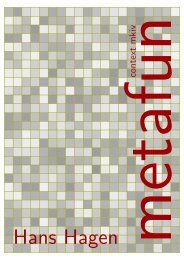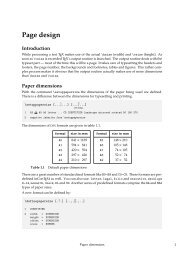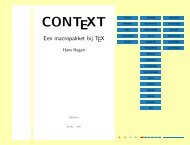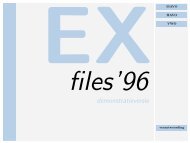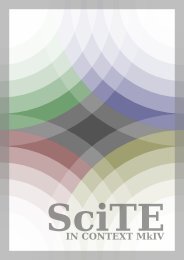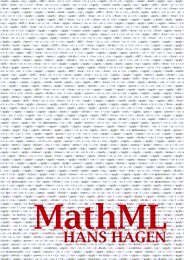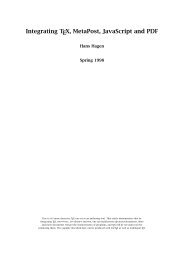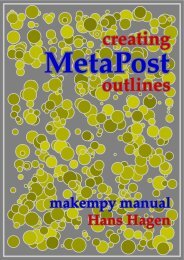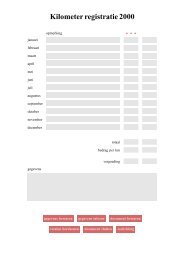Hagen - Pragma ADE
Hagen - Pragma ADE
Hagen - Pragma ADE
Create successful ePaper yourself
Turn your PDF publications into a flip-book with our unique Google optimized e-Paper software.
90<br />
Features<br />
local defaultfraction = 0.85<br />
local compose = {<br />
DY = defaultfraction, -- uppercase compensation<br />
}<br />
return {<br />
name = "lucida-one",<br />
version = "1.00",<br />
comment = "Goodies that complement lucida.",<br />
author = "Hans and Mojca",<br />
copyright = "ConTeXt development team",<br />
compositions = {<br />
["lbr"] = compose,<br />
["lbi"] = compose,<br />
["lbd"] = compose,<br />
["lbdi"] = compose,<br />
}<br />
}<br />
Of course no one really needs this because OpenType Lucida fonts have replaced the<br />
Type1 versions.<br />
The next goodie table is dedicated to the de facto standard T E X font Latin Modern.<br />
There is a bit of history behind this file. When we started writing ConT E Xt there were<br />
not that many fonts available and so we ended up with a font system that was rather<br />
well suited for the predecessor of Latin Modern, called Computer Modern. And because<br />
these fonts came in design sizes the font system was made such that it could cope efficiently<br />
with many files in a font set. Although there is no additional overhead compared<br />
to small font sets, apart from more files, there is some burden in defining them. And,<br />
as they are the default fonts, these definitions slow down the initialization of ConT E Xt<br />
(which is due to the fact that the large typescript definitions were loaded and parsed).<br />
So, at some point the decision was made to kick out these definitions and move the burden<br />
of figuring out the right size to Lua. When Latin Modern is chosen as font the effect<br />
is the same when design sizes are enabled. But, instead of many definitions (one for<br />
each combination of size and style) we now have an option. A non-designsize typeface<br />
is defined as follows:<br />
\starttypescript [modern,modern-base]<br />
\definetypeface [\typescriptone] [rm] [serif] [modern] [default]<br />
\definetypeface [\typescriptone] [ss] [sans] [modern] [default]<br />
\definetypeface [\typescriptone] [tt] [mono] [modern] [default]<br />
\definetypeface [\typescriptone] [mm] [math] [modern] [default]<br />
\quittypescriptscanning<br />
\stoptypescript<br />
The designsize variant looks like this:



